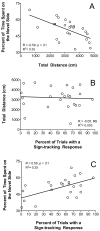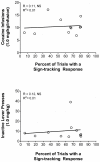Novelty seeking, incentive salience and acquisition of cocaine self-administration in the rat
- PMID: 20655954
- PMCID: PMC2975769
- DOI: 10.1016/j.bbr.2010.07.022
Novelty seeking, incentive salience and acquisition of cocaine self-administration in the rat
Abstract
It has been suggested that incentive salience plays a major role in drug abuse and the development of addiction. Additionally, novelty seeking has been identified as a significant risk factor for drug abuse. However, how differences in the readiness to attribute incentive salience relate to novelty seeking and drug abuse vulnerability has not been explored. The present experiments examined how individual differences in incentive salience attribution relate to novelty seeking and acquisition of cocaine self-administration in a preclinical model. Rats were first assessed in an inescapable novelty task and a novelty place preference task (measures of novelty seeking), followed by a Pavlovian conditioned approach task for food (a measure of incentive salience attribution). Rats then were trained to self-administer cocaine (0.3 or 1.0 mg/kg/infusion) using an autoshaping procedure. The results demonstrate that animals that attributed incentive salience to a food-associated cue were higher novelty seekers and acquired cocaine self-administration more quickly at the lower dose. The results suggest that novelty-seeking behavior may be a mediator of incentive salience attribution and that incentive salience magnitude may be an indicator of drug reward.
Copyright © 2010 Elsevier B.V. All rights reserved.
Figures




References
-
- Bardo MT, Neisewander JL, Pierce RC. Novelty-induced place preference behavior in rats: effects of opiate and dopaminergic drugs. Pharmacol Biochem Behav. 1989;32:683–689. - PubMed
-
- Boakes RA. Performance on learning to associate a stimulus with positive reinforcement. In: Davis H, Hurwitz H, editors. Operant-Pavlovian Interactions. Erlbaum; Hillsdale, NJ: 1977. p. 67.
Publication types
MeSH terms
Substances
Grants and funding
LinkOut - more resources
Full Text Sources
Other Literature Sources

